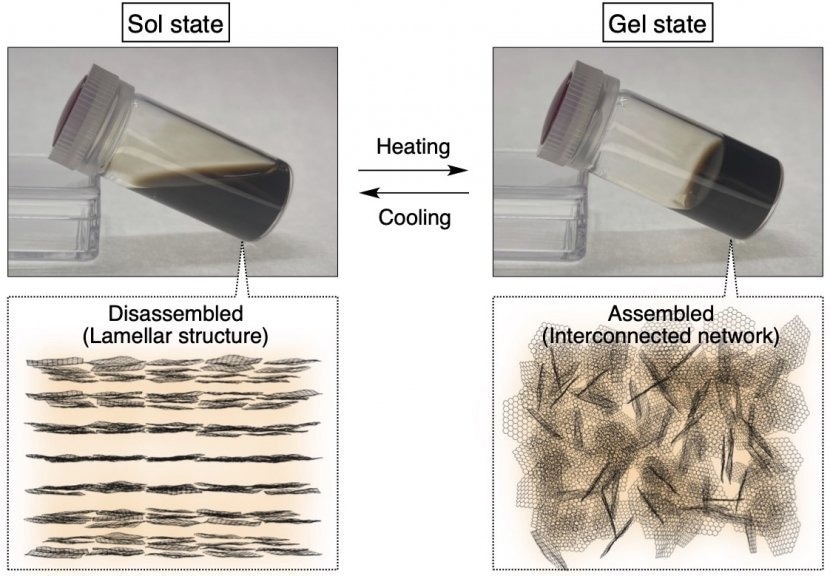Thermoresponsive graphene-oxide (GO) nanosheets are up-and-coming for varied applications, like smart surfaces and membranes, biomedical systems, and hydrogel actuators. At present, they are synthesized by altering GO nanosheet surfaces with thermoresponsive polymers.

GO nanosheets with tetrabutylammonium countercations undergo a sol–gel transition upon heating, moving from a disassembled lamellar structure to an assembled interconnected network. This technology can be harnessed as a direct writing ink for constructing three-dimensionally designable gel architectures. Image Credit: Koki Sano and Shoma Kondo from Shinshu University
Scientists from Shinshu University have taken things to the next level with the use of target countercations to impart the thermoresponsive features to GO nanosheets themselves, setting the stage for next-generation smart materials.
Recently, graphene-based two-dimensional materials have emerged as a target of scientific exploration thanks to their outstanding structural, electrical, mechanical, optical, and thermal properties. Among them are nanosheets relying on graphene-oxide (GO), an oxidized derivative of graphene, with extra wide and ultrathin dimensions and oxygen-rich surfaces.
Functional groups that comprise O2, like carboxy and acidic hydroxy groups, produce dense negative charges, creating GO nanosheets colloidally stable in water. Consequently, they are valuable building blocks for next-generation operational soft materials.
Specifically, thermoresponsive GO nanosheets have gained much attention for their broad-ranging applications, from smart membranes and surfaces and recyclable systems to biomedical platforms and hydrogel actuators. Nevertheless, the existing synthetic strategies for producing thermoresponsive behaviors involve altering GO nanosheet surfaces with thermoresponsive polymers like poly (N-isopropylacrylamide). This process is complicated and has possible restrictions in resulting functionalization efforts.
To overcome this difficulty, scientists headed by Assistant Professor Koki Sano and Mr. Shoma Kondo from the Department of Chemistry and Materials at Shinshu University in Japan have recently presented a breakthrough method known as “countercation engineering” to impart the required thermoresponsive capacity to GO nanosheets themselves.
On July 24th, 2023, their work was published online, and on August 9th, 2023, it was published in the journal ACS Applied Materials & Interfaces.
This study introduces a simplified and efficient route to achieving thermoresponsiveness by capitalizing on countercations (positively charged ions) inherently present in GO nanosheets. The control over these countercations offer a powerful tool for engineering stimuli-responsive nanomaterials.
Dr. Koki Sano, Assistant Professor, Shinshu University
In their work, the scientists demonstrated a powerful synthetic protocol that involves a two-step reaction in water to process GO nanosheets with particular countercations. Firstly, an exchange reaction substituted the countercations of the carboxy and acidic hydroxy groups with protons.
This was followed by an acid–base reaction with the use of a hydroxide anion with the target counteranions, leading to the desirable GO nanosheets. Systematic examinations into their thermoresponsive behavior showed that GO nanosheets harboring tetrabutylammonium (Bu4N+) countercations featured an inherent thermoresponsive nature in aqueous environments with no need for any thermoresponsive polymers.
Besides, the scientists established a reversible sol−gel transition indicated by self-assembly and disassembly processes. After heating, the lamellar Bu4N+-based GO nanosheets with electrostatic repulsion (sol state) between them reassembled to make an interconnected network that is rather led by van der Waals attraction (gel state). This notable transition can, indeed, be harnessed to build a direct writing ink for developing three-dimensional designable gel architectures of the GO nanosheets, highlighted the scientists.
Altogether, the outcomes of the work have insightful implications.
The controlled synthesis of GO nanosheets with tailored countercations has unveiled a pathway to versatile and simplified thermoresponsive materials. The thermoresponsive GO nanosheets are promising building blocks for biomedical, energy, and environmental applications, such as smart membranes, soft robotics, and recyclable systems, hydrogel actuators, and biomedical solutions. Moreover, the ability to directly write with GO nanosheet dispersions offers a new dimension to material design, enabling the construction of intricate gel structures with ease
Dr. Koki Sano, Assistant Professor, Shinshu University
It looks like “countercation engineering” could set the stage for new stimuli-responsive nanomaterials and even a new age in smart materials development.
Journal Reference
Kondo, S., et al. (2023) Countercation Engineering of Graphene-Oxide Nanosheets for Imparting a Thermoresponsive Ability. ACS Applied Materials & Interfaces. doi.org/10.1021/acsami.3c07820